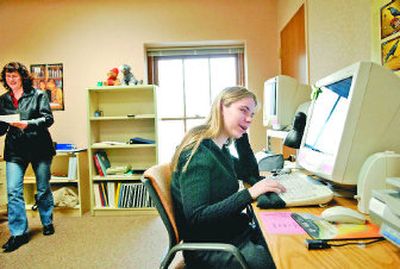Virtual learning faces budget reality

Amanda Hughes needs 53 books to study one calculus class at Lewis and Clark High School.
The 17-year-old is blind, and all her textbooks are converted to Braille.
“They can get pretty heavy,” not to mention the challenge she faces navigating crowded hallways, Hughes said.
This is why the junior was quick to sign up for classes through Spokane Virtual Learning, Spokane Public Schools’ online program. A computer software program reads online assignments aloud to her.
“It’s just good to have the option,” Hughes said.
Despite growing demand – enrollment in the online school has tripled to more than 300 students this year – there might be fewer online options next year for Spokane students like Hughes.
Included in possible budget cuts announced this month by district officials are some online class offerings. The district proposed cutting classes with fewer than 15 students, for savings of about $200,000.
Students registered for more than six classes will be required to pay for additional classes through SVL, said Sharon Johnston, coordinator for virtual learning. For example, a student taking five classes at school and two classes online would pay $225 per semester for the seventh class. Before, classes were free.
Despite budget woes, the district said the investment in online learning is vital, and the demand is great.
“It really provides equal access for every student,” Johnston said.
The district expects to offer 29 or 30 courses next fall by cutting two classes and combining others, said Johnston. Those include every class a freshman or sophomore would be required to take. Students can take online courses not offered in high schools, such as Advanced Placement Statistics or AP Spanish. Other unique online courses include a journalism course taught by Erin Daniels, adviser of The Vox, a student newspaper published by The Spokesman-Review.
By taking required courses online, students can take more elective classes.
“Kids and parents are asking for the virtual option; if we don’t offer it, they will seek it elsewhere,” Johnston said.
A growing number of privately owned, for-profit virtual academies are popping up throughout the state, which could mean fewer state dollars for some school districts.
In August 2005, the Legislature allowed private companies to partner with school districts to offer statewide online programs. Public school districts buy the curriculum from private companies, and when students enroll, the district gets the state funding for those students.
Several partnerships have come to Eastern Washington to recruit students, including the Washington Virtual Academy. WAVA is sponsored by the Steilacoom School District southwest of Tacoma and is run by K12 Inc., a company that produces the curriculum. The online school enrolls more than 600 students in kindergarten through eighth grade.
Portland-based Insight enrolls more than 600 high school students and is offered through the Quillayute Valley School District in Clallam County, Wash.
The Idaho Virtual Academy – also run by K12 and Idaho’s largest online school – enrolls more than 1,700 students, a quarter of whom live in North Idaho.
Spokane teachers created the curriculum for SVL, and the district receives no state funding for the program. Sometimes school districts offer to pay fees for their students who take SVL courses so they don’t lose the state funding.
For-profit online schools don’t provide that option.
“These for-profit schools use massive marketing programs and are backed with private money. If we operate in the black, all that money goes back into programs for the students, not for bottom-line profit,” said Mark Selle, superintendent of the Valley and Orient school districts in Stevens County.
Selle co-founded Columbia Virtual Academy, one of the newest of Washington’s nonprofit K-12 online schools.
Most of CVA’s 400 online students are home-schooled, but the program also partners with 12 school districts in the state – West Valley, Freeman and Deer Park among them – to offer online courses.
West Valley pays $180 per class for students from RiverCity Learning Academy – a 50-student project-based alternative high school – to take foreign language and chemistry classes online. That’s less expensive than hiring staff to teach the classes, district officials said.
“Everybody sees virtual learning as a moneymaking venture,” said Johnston of Spokane Virtual Learning. “But you don’t make the money immediately; it takes time to build your courses and build your system.”